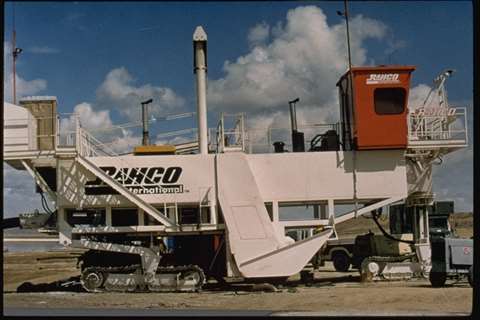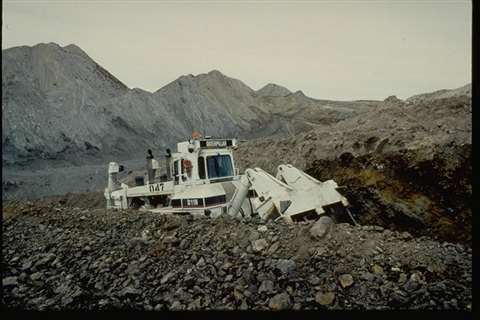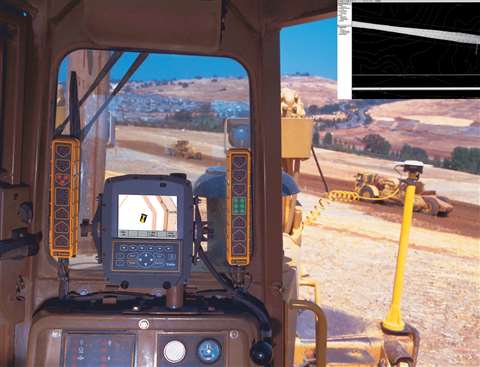A history of machine control: part one
24 January 2023
 This picture, taken in 1993, shows an early version of machine control
This picture, taken in 1993, shows an early version of machine control
Machine control has forever changed the way roads are paved, dirt is moved and holes are drilled. It has improved productivity, efficiency, quality and provided measurable sustainability improvements – transforming the way buildings, roads, bridges and other assets are built around the world. But it didn’t happen overnight.
Over the last two decades, machine control systems have been implemented on all sizes of machines, from excavators and dozers to track loaders and skid steers.
While not yet on every jobsite, the technology is firmly established in the industry, with manufacturers even preloading capabilities on machines at the factory. The innovations made and lessons learned over the years have become a foundation for emerging autonomous solutions.
Few likely remember that the magic of machine control began almost 60 years ago and progressed largely due to creative thinkers and the leaders who gave them the freedom to explore the application of innovative technologies in new and different ways.
Laser focused machine control
Machine control on heavy equipment has been around since the 1960s with the advancement of lasers. At the time, the Hughes Research Laboratory in California, US, built the first laser prototype, an optical resonator that created a narrow beam of light. That technology would become the foundation for military-grade range finders. The ability to measure the distance between the instrument and a target quickly attracted the attention of the agricultural community.
The story goes that there were two concurrent advancements. The first laser grade control was developed by agricultural engineers James Fouss and Norman Fausey of The United States Department of Agriculture (USDA’s) Agricultural Research Service (ARS) at The Ohio State University in the mid-1960s for an agricultural drainage machine. Using photocells mounted on trenching and plow-type drainage machines, the system automatically raised and lowered the digging device to a controlled depth and subsurface grade dictated by a laser beam set to the desired elevation and grade. The necessary signal processing circuit was designed and fabricated for ARS by Control Systems Co. of Urbana, Ohio, which was co-owned by Ted L. Teach.
Around the same time, Robert H. Studebaker, of Tipp City, Ohio, began to develop a laser controlled motor grader using a rotating prism to create a ‘plane’ of laser light that could control several machines on a field for flat and sloping planes.
In 1967, Studebaker and Teach formed Laserplane Corp., the first laser company. The subsequent advances led to the first demonstration of laser control on a trenching machine in September 1968 at the Ohio State Farm Science Review by ARS researchers and Laserplane.
Sonic sensors
 Machine control was still in its infancy when this picture was taken in 1996
Machine control was still in its infancy when this picture was taken in 1996
Soon, these innovators would add sonic sensors, instruments that measure the distance to an object using ultrasonic sound waves. The sonic sensors expanded machine control from cutting flat or sloping planes, to controlling machines such as motor graders and pavers for both elevation and steering. These sensors allowed a machine to follow a non planar surface (e.g., stringline, curb line, edge of seal) in elevation and a horizontal alignment.
The combination of rotating lasers and sonic tracers established the first generation 1D/2D machine control solutions (elevation and steering) that continued to evolve over the coming years. The result was a dual automatic blade control solution, called the BladePro System.
“It was a pretty crude system that relied on an off-the-shelf black and white screen and a handheld computer,” said Mark Forrest, then working for Spectra Precision as the Product Manager. “But we could automatically control the cross slope of the blade on the motor grader. Then we added an ultrasonic sound sensor to measure a relative elevation, so that we stayed above the stringline.”
In 1995, Forrest moved to Dayton, Ohio to be a product manager for this early machine control solution.
It wasn’t until the late 1990s that two advances – the robotic total station and GPS – would jump-start the evolution of 3D machine control. Spectra Precision would have competition for these early solutions very soon. Topcon Laser Systems Inc. was established in 1994, the same year Topcon acquired Advanced Grade Technology, its entry into the 2D machine control business.
Motor Graders and machine control
In 1996, Steve Berglund took over as the president of Spectra Precision and formed a team to “see how we could move existing machine control to 3D,” recalled Forrest. Spectra Physics had merged its Geotronics Division to become just Spectra Precision. They had also acquired a small software company called Plus3 that had a product called Terramodel.
“Rather than a surveyor setting stringlines for machines to follow, we wanted to automatically control those machines as they moved,” Forrest said.
The next development, shown at Bauma in 1998 was called BladePro 3D. BladePro 3D was a system that combines a robotic total station with digital terrain model (DTM) design software to automatically control elevation and cross slope of a motor grader blade, eliminating the need for stringlines.
Hexagon/Leica Geosystems would also begin to move into the 3D machine control space. With the acquisition of Magnavox in 1994, Leica would have its first GPS product. In 2000, it would acquire Laser Alignment Inc. to combine with its GPS capabilities as a foundation to its 3D machine control technology.
 Trimble machine control being used on a dozer. Picture taken in 1999
Trimble machine control being used on a dozer. Picture taken in 1999
But it was the commercialization of GPS that would provide the much needed utility to make blade control relevant for the masses – Bryn Fosburgh, a physical scientist with the U.S. Army Corps of Engineers (USACE) at the time, remembers these days well.
GPS receiver
In 1991, as a member of the Army Research team, formerly the Engineering Technology Laboratory (ETL) at Fort Belvoir, Virginia, Fosburgh’s job was to research GPS and its applications for the civilian and military sectors of the U.S. Army. The focus was largely related to the dredging research program using differential GPS and real-time kinematic (RTK) positioning. He was a member of the USACE RTK Team, working with Ben Remondi, a GPS RTK pioneer. USACE later worked with Caterpillar through a small business innovation research (SBIR) contract to put RTK on a machine.
Subsequently, Trimble would introduce its first RTK GPS receiver in 1992 and Fosburgh would join Trimble in 1994 and help guide the next evolution of GPS and RTK.
“Charlie Trimble saw GPS as the next utility,” said Fosburgh. “He gave all of us engineers full rein to find ways to proliferate it on any platform.”
The second part of this article will be published next week.





